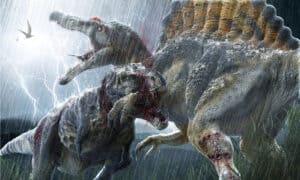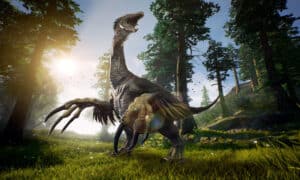Oregon’s geologic record dates as far back as 400 million years, specifically during the Devonian period. At the time, the region known today as the state of Oregon was submerged under water. It remained so throughout the entire prehistoric period, up until the start of the Paleocene.
In terms of fossils, the earliest records consist of conodont, coral, and plant findings. Later, during the Mesozoic era, when the state was riddled with volcanic islands and seaways, the area was inhabited by pterosaurs, ichthyosaurs, and invertebrates.
Fossils found throughout the state date back to the Cenozoic, Mesozoic, and Paleozoic periods. In fact, the oldest known rock formations in the state are found in the Klamath and Blue Mountains, the former being a fossil locality.
Oregon should be a target for any fossil enthusiast, as the state hosts a total of nine fossil localities that can be admired and an additional two protected areas.
What Makes Oregon Interesting in Terms of Fossils?
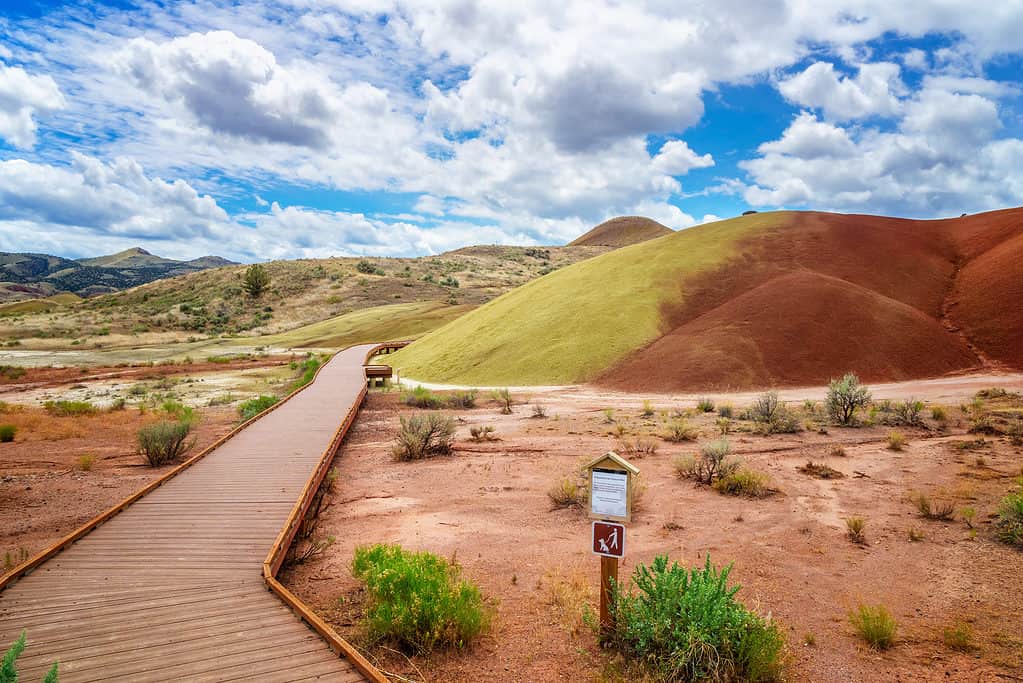
Oregon is home to the John Day Fossil Beds National Monument.
©MattLphotography/Shutterstock.com
Oregon has a distant history when it comes to the uncovering and collection of fossils. The area’s inhabitants from 11,000 years ago are known to have collected fossils and shaped them into various decorative pieces. They made jewelry and even decorative furniture. This would happen in the city of Fossil (ironically). This is where archeologists found a site with rock fossils stacked in a corner, seemingly for decorative reasons.
Moreover, Oregon is also home to the John Day Fossil Beds National Monument, known for its well-preserved fossil layers attributed to both mammals and plants dating back to the Miocene and Eocene periods.
Last but not least, the interesting thing about Oregon is that archeologists believe that no dinosaurs have ever lived in the state. While it has everything from prehistoric plants to vicious marine reptiles, dinosaurs probably weren’t among Oregon’s inhabitants!
What Is a Dinosaur?
To understand why none of Oregon’s discovered fossils can be called dinosaur remains, it’s important to take a close look at what the term dinosaur means. According to the definition, a dinosaur is any extinct animal that featured upright limbs and lived specifically on land between 252 and 66 million years ago – more specifically, during the Mesozoic Era.
As you can see, given that most of the world was submerged in prehistoric times, the only relevant inhabitants were large marine reptiles, such as ichthyosaurs. In regions where land mass was present, one could also identify fossils of pterosaurs, prehistoric flying reptiles that could be called dinosaurs, except that they’re not part of the Dinosauria clade; they were flying reptiles.
This is one of the essential aspects that must be considered when talking about dinosaurs, especially if you want to learn more about them.
2 Dinosaurs that Might Have Lived in Oregon
Luckily for The Beaver State, it was mostly submerged under water during the Mesozoic era, with the exception of the mentioned volcanic islands. While it is believed that no dinosaurs lived there then, some discovered fossils are thought to have been transported by sea from other locations. As you’ll see soon enough, the Oregon area is riddled with bits and pieces of actual dinosaurs, such as hadrosaurs.
According to scientists, these fossils’ presence results from a bloat and float phenomenon. In short, the dinosaur may have died in its natural habitat, on land, and then been carried by the seas of the time until it floated and bloated as a result of the accumulation of decomposition gasses. Ultimately, the dinosaur’s body would burst, and, in some cases, bone fragments would remain intact and fossilize.
How Many Dinosaur Fossils Have Been Discovered in Oregon?
Only two dinosaur fossils (non-avian) have been discovered in the state of Oregon – attributed to the clades of ornithopods and hadrosaurids. One is an ornithopod pedal phalanx, while the other is a hadrosaur sacrum fragment.
The phalanx is believed to belong to an Eolambia or Tenontosaurus specimen (from the Early Cretaceous period), while the sacrum fragment might belong to a Lambeosaurus (from Late the Cretaceous).
As for the location of their discovery, the phalanx was found in Hudspeth Shale. The sacrum fragment was discovered in the sandstones at Cape Sebastian, on Oregon’s southern coast.
1. Ornithopods
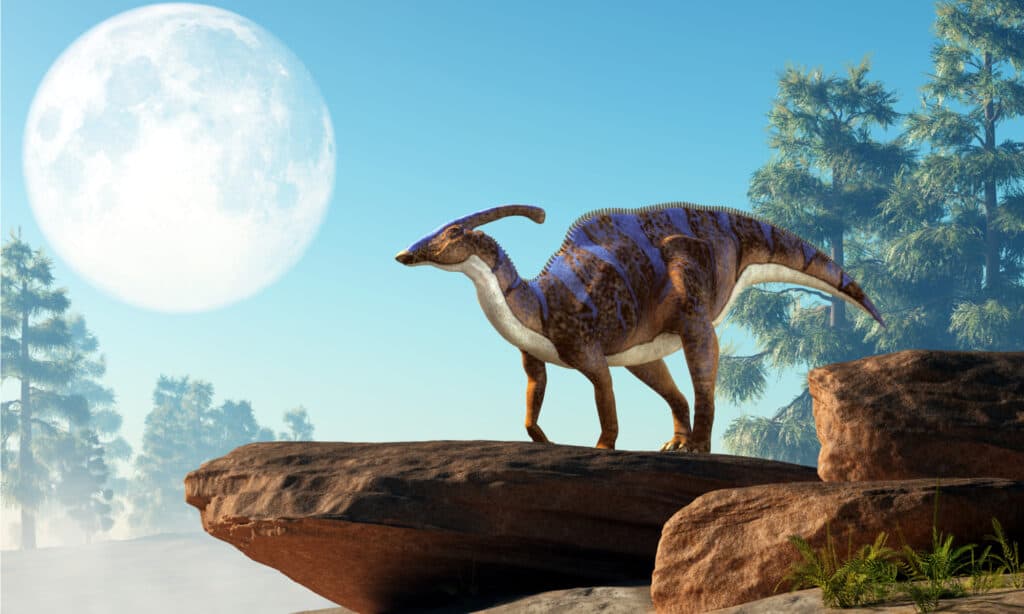
Ornithopods lived between the Middle Jurassic and Late Cretaceous periods, about 164 to 66 million years ago.
©Daniel Eskridge/Shutterstock.com
They are part of the Ornithopoda clade of dinosaurs. Living between the Middle Jurassic and Late Cretaceous periods, about 164 to 66 million years ago. Today, ornithopods are known as successful herbivores of the Cretaceous era, having dominated North America, despite their initially small stature.
The scientific name of the clade, Ornithopoda, refers to the main characteristic of these dinosaurs – their bird feet, featuring three toes (sometimes four toes as well). Regarding size, early clade specimens were small, growing up to about 3 feet (1 m) long. However, evolution left its mark, as the largest species of ornithopods, such as the Shantungosaurus, could grow up to 50 feet (15 m) long and have a weight of about 25 short tons (23 metric tons).
Throughout their evolutionary period, ornithopods experienced many changes; the smallest were bipeds and the size of a big dog. At the same time, the largest specimens would be twice the height of a modern human and about 32 feet (10 m) long.
2. Hadrosaurids
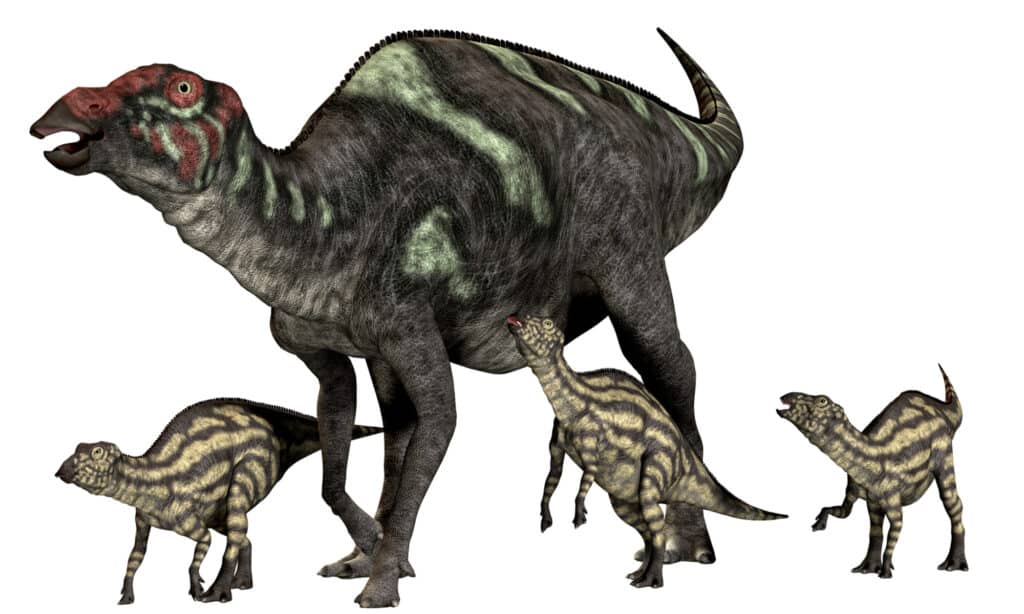
Hadrosaurids are commonly known as duck-billed dinosaurs.
©Catmando/Shutterstock.com
More commonly known as duck-billed dinosaurs. Their scientific name, Hadrosauridae, translates as “thick lizard.” It should be noted that the Hadrosauridae family belongs to the Ornithopoda clade. In short, you could say that there’s a single type of dinosaur that might have lived in Oregon – the ornithopod.
This type roamed the Earth between 86 and 66 million years ago, during the Late Cretaceous period. It is thought to be a direct descendant of the iguanodontia dinosaurs because it has the same body shape.
They are distinguished by their flattened and stretched (laterally) rostral bones. This is the aspect on which the duck-billed dinosaur name was based. The as the mentioned rostral bones gave the creatures a duck-bill-like appearance.
Where to See Fossils Today in Oregon?
In Oregon, fossils can be seen at any of the nine fossil locations, in two protected areas, and in two natural history museums. The nine fossil locations are as follows:
- Astoria Formation – fossils from the middle Miocene period;
- Blue Mountains – some of the oldest rocks in Oregon can be found here;
- Coyote Butte Formation – fossils from the Sakmarian to Kungurian stages of the Permian (roughly 23 million years old);
- Curry County;
- Fossil Lake – contains fossils over two million years old (mammals, birds, fish);
- Keasey Formation – fossils from the Paleogene period;
- Nye Formation – fossils from the Neogene period;
- Pittsburg Bluff Formation – fossils from the Paleogene period;
- Wallowa Mountains – sedimentary deposit from the Triassic period.
The two protected areas are:
- John Day Fossil Beds National Monument – about 14,000 acres (5,700 ha) of badlands, riparian areas, and semi-desert shrublands that form well-preserved layers of fossils from the late Eocene and late Miocene periods;
- Paisley Caves – contain the evidence of the oldest definitively-dated North American human presence.
The two natural history museums you can visit are:
- University of Oregon Museum of Natural and Cultural History – the home of almost 100,000 fossils gathered from Oregon, the Pacific Northwest area, and the entire world. The museum also shelters almost one million archaeological artifacts of great importance (including the oldest shoes in the world);
- Thomas Condon Paleontology Center.
As you can see, there are more than enough places to see fossils in Oregon! The great thing about this state is that you can go about finding fossils yourself in one of the nine locations mentioned above. You can schedule a visit to the University of Oregon Museum of Natural and Cultural History and explore one of its many fossil exhibits.
What Is the State Fossil of Oregon?
The state fossil of Oregon is the dawn redwood Metasequoia occidentalis, which dates back to the Oligocene period. It is an extinct species of Metasequoia that lived from the Late Cretaceous to the Pliocene epochs.
Metasequoia occidentalis was a deciduous redwood tree that was found fossilized throughout the world. It is found from the United States (Oregon included) to Canada, Russia, Japan, China, Svalbard, and Greenland. However, it is considered a rare fossil in Europe.
Up Next:
- Discover 10 Extinct Animals That Lived in Oregon
- How Did Dinosaurs Go Extinct?
- How Long Were Dinosaurs on Earth?
The photo featured at the top of this post is © Daniel Eskridge/Shutterstock.com
FAQs (Frequently Asked Questions)
What is the John Day Fossil Beds National Monument?
Oregon is home to the John Day Fossil Beds National Monument, known for its well-preserved fossil layers attributed to both mammals and plants dating back to the Miocene and Eocene periods.
Why aren't there many dinosaur remains in Oregon?
Luckily for The Beaver State, it was mostly submerged under water during the Mesozoic era, with the exception of the mentioned volcanic islands. While it is believed that no dinosaurs lived there then, some discovered fossils are thought to have been transported by sea from other locations.
Thank you for reading! Have some feedback for us? Contact the AZ Animals editorial team.




